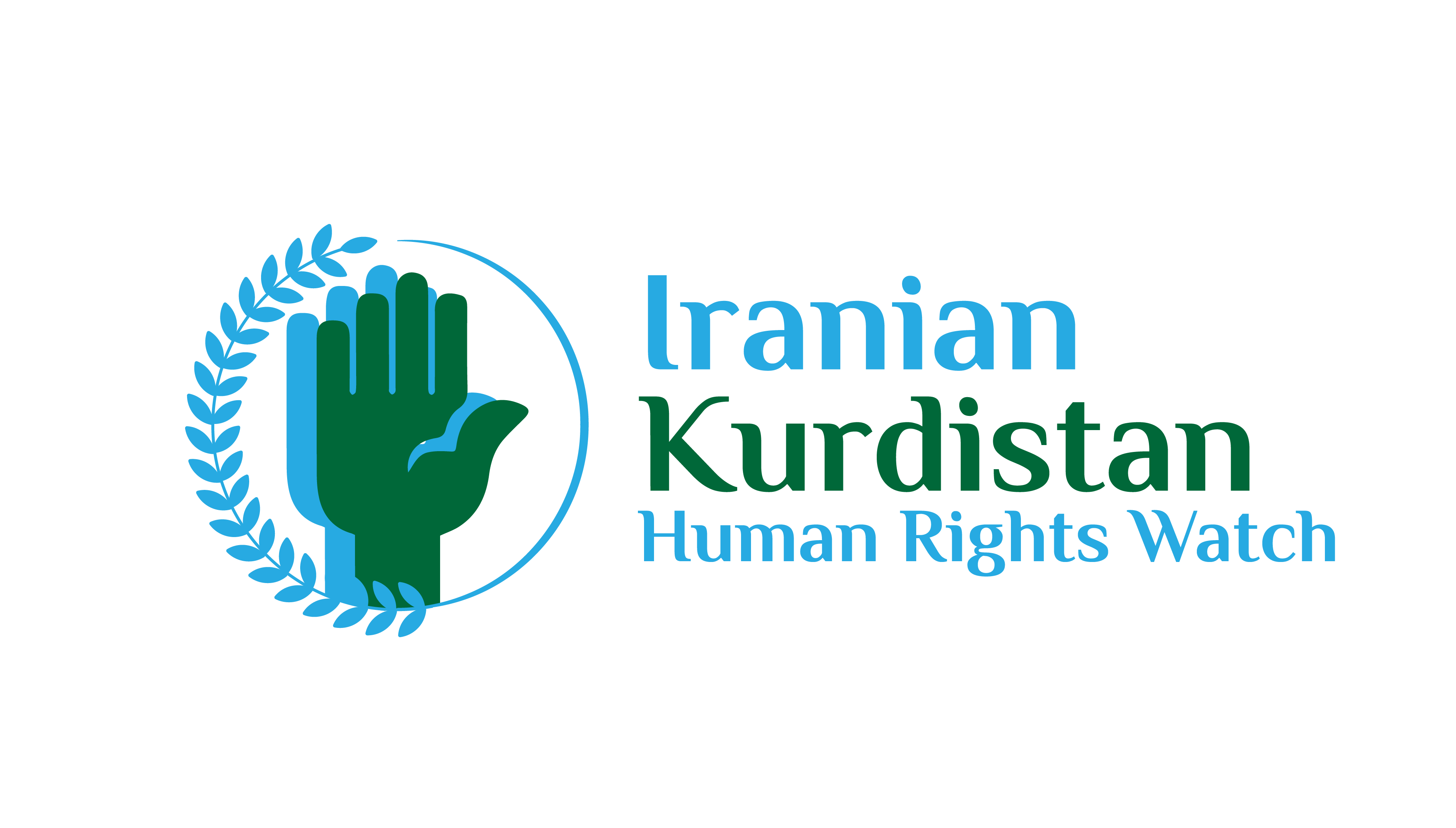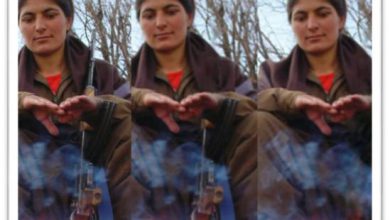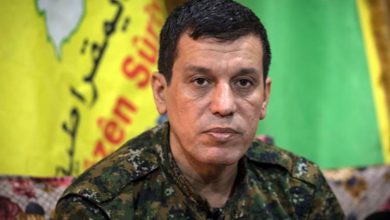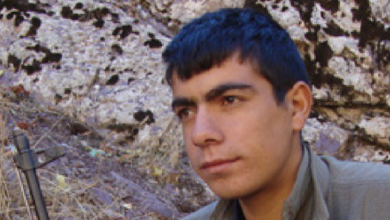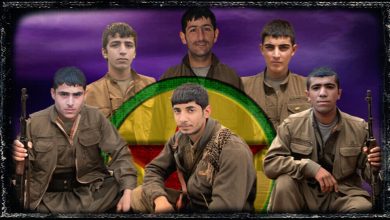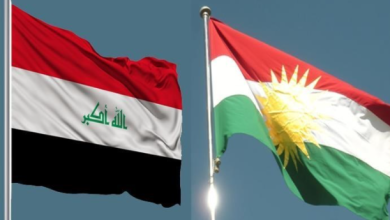A Special Case, the Photoshop-Spiced Human Rights
A Documented Report on Human Rights Case-Making against Iran
Introduction
In recent years, as political and economic pressure projects have begun against Iran under pretexts such as Iran’s acquisition of nuclear knowledge, Iran’s ability to defense missiles, especially strategic missile science, Iran’s advances in space technology and the deployment of satellites into space, in fact, another excuse has caused media war, pressure, threats and sanctions against Iran. This is the case-making under the pretext of human rights as a means of doubling pressure on the country.
This human rights record is being handled by human rights organizations and institutions, which has led individuals, countries and opposition groups in Iran to back double pressure by deceiving UN law enforcement agencies with the support of the West’s law enforcement agencies. They want to souble human rights instruments on Iran. Of course, these institutions and their Western backers have, in many cases, made big mistakes in filing human rights cases against Iran and have given false information to international institutions and public opinion. In fact, human rights, nuclear, missile and space gains, for Western nations, especially the United States, are merely a pretext and tool.
This report, documented and detailed, points to one of these false lawsuits against Iran that is trying to pressure Iran under the pretext of human rights. For the first time, this report releases amazing and important information. In preparing this documentary report, in addition to information available on the Internet and independent media research, several human rights activists and a former member of the PKK and PJAK militant group present their own documentation and findings, new dimensions of media warfare and human rights filing against Iran.
Zeinab Jalalian; Case-making against Iran with Confused Information
Zainab Jalalian, a Kurdish opposition activist and a member of armed ans separatist groups, was born in 1982 in the village of Dim Qeshlaq, a suburb of Maku, Iran. She became a member of PJAK (Iranian branch of the PKK armed group) in 2004 and claims to have been active as a social activist, education and aid worker. Jalalian was arrested in Iran (Kermanshah) in 2007 and sentenced to death in 2008 for collaborating with the PJAK armed group, carrying illegal weapons and other military equipment and armed action against Iran’s national security. But in 2011, she was granted a pardon and her sentence was reduced to life imprisonment. From the point of view of the US State Department, the European Union, Turkey and Iran, the PKK is a terrorist group whose branches engage in violent, illegal and terrorist activities.

Western human rights organizations report that Ms. Zeinab Jalalian, during interrogations and court hearings, has never accepted to have been armed at the time of her arrest. Western media and institutions allege that Ms. Jalalian has never denied her membership in a violent terrorist group called PJAK; she was helping the Kurdish women in education and social affairs and had no military or armed activity during her time in PJAK.

During the years that Zeinab Jalalian was serving her life sentence, these dependent media outlets tried to case-make for her and produce deceptive information about her, who became a member of the PKK and a victim of the dirty game at the age of 14. The PKK and the PJAK have used children as soldiers, to make them victim once again. In fact, the case-making against Iran re-victimized her.

The beginning of political and media pressure on Iran
Since her arrestation and trial, as well as the final verdict, various claims such as deprivation of treatment, imposing all forms of psychological and physical torture, failure to consent to medical leave, conviction in an unfair trial, deprivation of basic facilities, and medical leave, being forced to television confessions, restrictions on family conversation and control, inspections of personal belongings, and restrictions on the use of free air access and bathroom services have been alleged by predominantly Western groups, governments, individuals, and human rights organizations.
Media and human rights groups have claimed that “Zeinab Jalalian is at risk of losing her eyesight due to her pterygium eye disease. She has also suffered from severe intestinal infection and internal bleeding during her years of detention and needs urgent specialized treatment. Despite Zainab’s family’s readiness to pay for her treatment, Iranian security officials have refused to move her out of prison for treatment. “Another claim, “Her torture was after the arrest and during the process of being heard. Hitting her head to the wall so that it fractured the forehead and made theeyes swelling, she was slammed by cable, interrogated with blindfolds and bracelets while her arms and legs were chained together and threatened to be raped».[1] But the culmination of these human rights allegations and pressures on Iran was the entry of two apparently neutral human rights organizations into the case of Zeinab Jalalian and their complaint against Iran in the UN. In March 2014, on the occasion of the International Women’s Day and the seventh anniversary of Jalalian’s arrest, Justice for Iran organization, with the International Organization for Redress, filed a complaint in the United Nations Arbitrary Detention Task Force, reiterating the allegations, they demanded the release of Zainab Jalalian. The UN Arbitrary Detention Task Force is a part of the United Nations Human Rights Council, which reviews complaints received on human rights violations and calls for their response through five independent experts, giving their opinion to governments. As such, the two organizations have filed complaints and allegations against Iran, claiming that Jalalian’s basic rights have been violated in Iranian prisons and that she faces acute medical and medical problems and the Iranian government has not paid attention to. The two organizations called for the abolition of Jalalian’s life imprisonment and her immediate release.
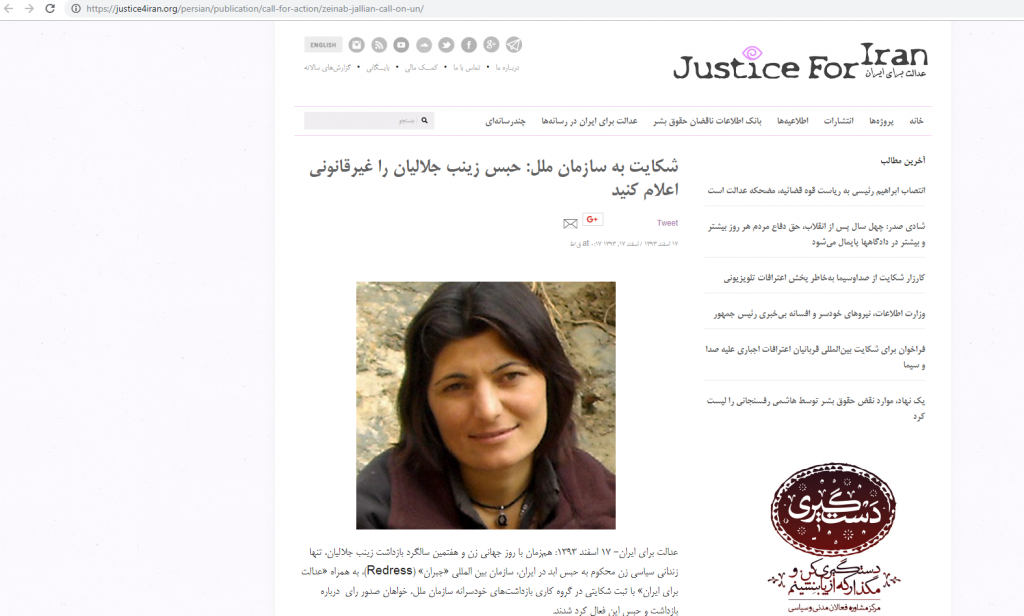
“Justice for Iran” and “Redress” complaint against Iranian government and judicial system to UN
At the same time as the complaint against Iran, Justice for Iran, in a 26-page report[1] examining Jalalian’s background and life, examined what it described as human rights violations in this individual’s case. Violations such as the prohibition of arbitrary detention, the right to access to legal advice and access to a lawyer, the prohibition of torture, the right to a fair hearing, the rights of the prisoner and her family to visit, the prisoner’s access to health care and the prisoner’s right to security and basic facilities are mentioned in the report. The report and, of course, the aforementioned complaint were also accused two Iranian court judges of human rights violations and demanded their response on the death sentence and appeal verdict issue. A significant part of the report was dedicated to the interviewing people close to the case.
The main demands of this report and its publishing organization were as follows:
• Abandonment of life imprisonment for Zeinab Jalalian due to numerous violations of human rights and citizenship in her case.
• Zeinab Jalalian should be transferred to a hospital for treatment as soon as possible and provided with the necessary medical care.
• Zeinab Jalalian should continue to enjoy the same rights as other prisoners, including the use of leave, visit, and health and welfare facilities under Iranian domestic law and international obligations while in detention.
• Compensate for damage imposed on Zeinab Jalalian and her family as part of the process of establishing justice and enforcing the international human rights obligations of the Islamic Republic of Iran.
• Security agents and judicial officials involved in the arrest, torture, trial and conviction of Zeinab Jalalian should be held accountable for human rights abuses, and in particular Judge Moradi, the head of the Kermanshah Revolutionary Court’s Branch and Judge Ali Mohammad Roshani, Judge of the Court of Appeal should be held responsible for the issuance and approval of the death sentence.
The main argument of the opponents and critics of Zeinab Jalalian’s verdict, including human rights organizations, was that she had never used a weapon and had no armed activity. As mentioned, they did not question the principle of her membership in groups such as the PKK and the PJAK (considered a terrorist group by the United States, Europe, Turkey and Iran). These groups insist that Zeinab Jalalian’s activities are purely civil and peaceful and she is an activist in the women’s field. In fact, they claimed serious human rights abuses by the Iranian government over the Jalalian case.
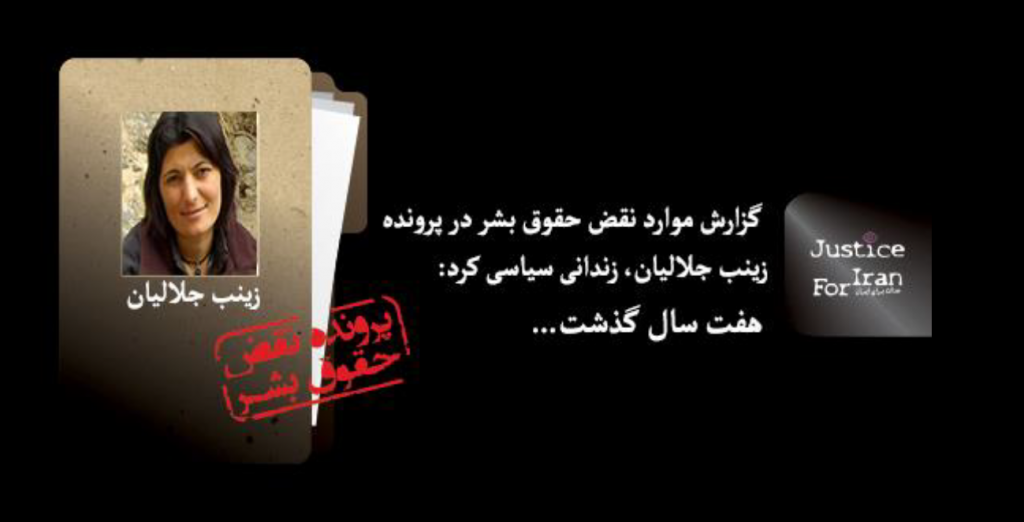
Family, as well as numerous international reports and statements by reputable human rights organizations say abducting girls and women are one of the constant practices of the PKK and PJAK terrorist groups. Various sources have confirmed that first of all Jalalian was most likely abducted at the age of 14 to 15 and taken to the PKK headquarters in the impassable highlands and, secondly, that her family had no information about her fate.
The kidnapping is obviously not aimed at turning a person or a member into a civil activist, and its main intention is to make the kidnapped a terrorist and a criminal. It is important to note that, according to the Jalalian’s family, as well as the explicit acknowledgment of the Justice for Iran organization, Zeinab’s sister Deniz Jalalian is currently serving as an armed memeber in the PKK and PJAK groups. She had joined PJAK earlier than Zeinab.
Zeinab’s poor family, certainly, did not have the ability to put her in a position to gain social and political recognition, while, even if we accept her voluntary membership, as PJAK says, Zeinab was 14 years old at the time and was a child soldier. So her entry into the PKK cannot be considered conscious. On the other hand, the organizational structure of the PKK is such that those present are subject to mind control training.
As the former members of the PKK and PJAK confirm, the group regularly and purposefully provides videos of assassination and ambush operations that have killed Turkish troops in order to present them to new members during the training. Former and/or escaped members of the PJAK and the PKK have claimed that watching these scenes was embarrassing upon arrival, but during the film’s release, commanders said members must shout for joy in order to be happy about killing others. This will eventually lead to people’s being cut off from their society, and the members will have nothing to do except Qandil and the PKK leaders. The result is to brain drain them.
PJAK group does not select its members among free and empowered youth and teenagers, but rather abducts and deceives them by fascinating slogans such as freedom, equality, combating cruelty, practically abducting young girls and boys and engaging in complex psychological operations. This makes them obedient people.
By choosing the impassable mountains, the group practically deprives members of returning to normal life and answers any criticism or question with an iron fist, and the fate of the protester is either jail or execution and physical removal. The group’s popularity has fallen sharply because of insecurity, terror and violence, as well as with atheistic slogans against Muslim Kurdish beliefs. PJAK has brought insecurity and underdevelopment for the Kurdish people under the mask of freedom of the Kurdish people, and by exploiting girls and victims. PJAK shows that it only needs pictures of those killed to continue its false propaganda. Deceiving women and adolescents, assassination and kidnapping, killing innocents and ordinary citizens, and drug trafficking are all part of the PJAK crimes.
There are many evidence for the truth of “deceiving members” by PJAK. Most of these people are not trained terrorists, but merely civilians, most of whom are deceived youths who were transferred to the impassable mountains by the group under the pretext of working in Iraq, and after being faced with the truth of this group, PJAK does not allow them to return and answers them by coercion, intimidation and reversal of the facts.
Thus, it can be said that what is important for the terrorist group PKK and PJAK is not the life of the members, but the abuse of members’ imprisonment and photographs in order to cover up their crimes and thus present them as victims of the Iranian government’s violence.
Manipulating the reality, lie propaganda and the photo-shopped human rights
In its report in English, the Association for Protecting the Women and Children’s Rights conducted an interview with Zahra Azadseresht, a co-prisoner for Jalalian. While rejecting all claims by organizations such as Justice for Iran, Ms Azadseresht explicitly emphasized that the Jalalians, like other prisoners, had used the facilities in the prison and had been sent to prison’s or outside hospitals as needed. In the Shadow of Terrorism document, Jalalian also explicitly acknowledged that her entire trial was fair and that she had not suffered any torture.
Zahra Azadseresht also mentioned a very important point: ” Zeinab Jalalian’s being a victim”. In fact, Jalalian herself has been a victim of PKK violence and mafia structures and kidnappings.” Azadseresht insisted that the non-execution of the death sentence for Jalalian had a positive effect on his morale and even made Zeinab hopeful to be pardoned in the coming years. Another very important point in Zahra Azadseresht’s remarks is that she is not well educated and has learned to read and write only in prison, and is unable to write letters published by her name at all. The letters may have been written and published by human rights bodies in her name. The remarks were also confirmed by Mohammad Sharif (Jalalian’s lawyer). Dr. Sharif (a founding member of the Human Rights Defenders and Security Prisoners’ Advocate in Iran) believes that Jalalian is not well educated and that the remarks in the Justice for Iran report and the Redress Institute indicate that Jalalian was a woman activist and had a speech in this regard. That is, all false and far from the truth.

A very important point: To study the Joint Report of Justice for Iran and Redress in order to reveal the veracity and accuracy of its contents.
The report appears to contain some misleading information. This is probably due to two things:
1. The commissioners of the above report are cover organizations related to the PKK and PJAK;
2. Given the history of tensions between Iran and the West, so-called human rights groups are attempting to impose new sanctions and pressure on Iran through human rights instruments, women and the issue of execution.
As a result, putting together false images and some inaccurate information is likely to deceive the UN Arbitrary Detention Task Force, and the Working Group has erroneously voted against the Government of the Islamic Republic of Iran.[1] The manipulation of Zeinab Jalalianîs photo in the report indicates the deliberate misrepresentation of anti-Iranian information. The photo provided by the two entities to the United Nations Arbitrary Detention Task Force is, in fact, the manipulated photos 1 to 3:



the three photos above show a Kurdish woman as a civilian and unarmed
But the reality is something else,and that is the manipulation of photos by so-called neutral entities! In Figures 4 and 5, Zeinab Jalalian is seen wearing a formal PKK and PJAK uniform and a Kalashnikov rifle (PKK and PJAK official and organizational weapon). In fact, a member of the terrorist and separatist group has been presented as an innocent civil and human rights activist by Photoshop.

Jalalian with organizational weapon and uniform of PJAK and PKK
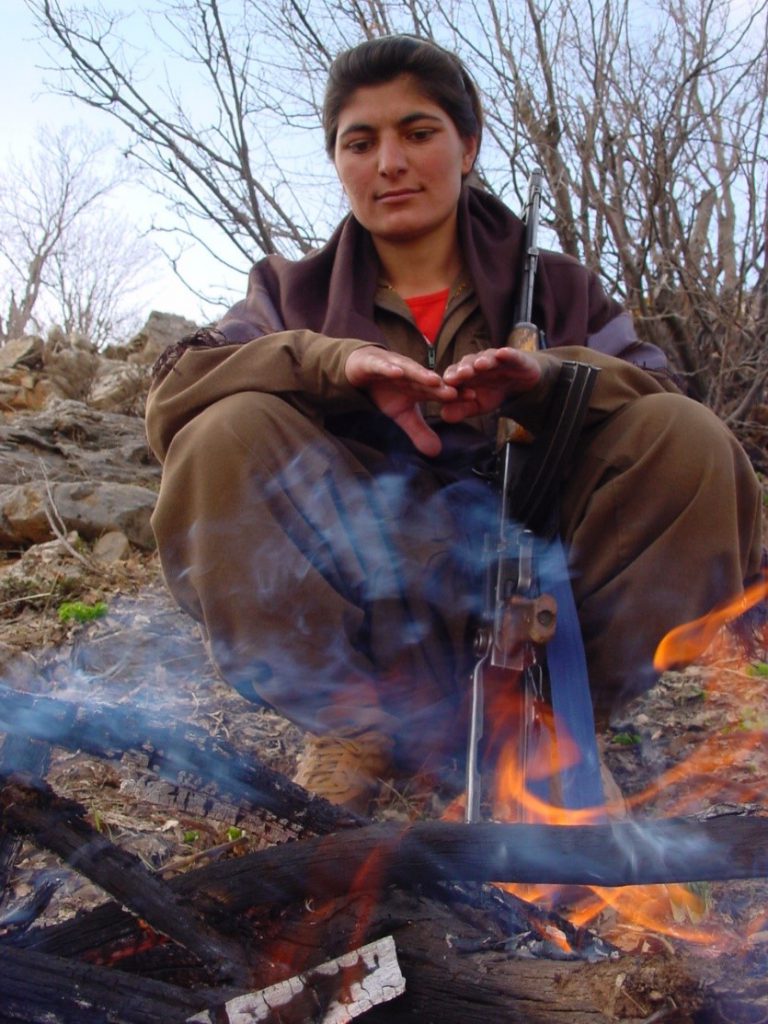
Jalalian with organizational weapon and uniform of PJAK and PKK
In photos 6 and 7, the gun has been removed


The manipulation of Jalalian’s photo not only has not benefited her, but has also raised suspicions among Iranian security and judicial officials that Zeinab Jalalian herself may have cooperated with the two entities in reporting the wrong. It has also caused scandal for both Justice for Iran organization and Redress institute, because they both intend to deceive the United Nations and by misrepresenting public opinion, even endangering the life of a victim of kidnapping and violence, Zeinab Jalalian. Therefore, it can be concluded that other reports of these two entities, especially on the human rights situation in Iran, were written for political purposes and were untrue.
Conclusion: Justice for Iran: A Notorious Political Organization
The main organization for producing a false report to the UN is the Justice for Iran. Shadi Amin, who describes herself as a “feminist and gender equality activist” and Shadi Sadr, are in charge of the organization. These two women’s rights activists are known for adopting anti-religious and anti-Iranian approaches and play an important role in filing human rights cases against the Iranian government. As such, it is clear that behind the scenes of human rights pressure on Iran are political groups whose aim is not to save lives or improve the status of justice in Iran, but rather to pressure and sanction Iran with the aim of changing the system and religious beliefs of the people. It is true that Zeinab Jalalian and other PKK and PJAK members have joined an armed group that is terrorist in nature and is blacklisted by the EU, US, Turkey and Iran, but Zeinab Jalalian herself, as a victim, must not be forgotten. The victim of the kidnapping, sectarian, authoritarian, and anti-women structures of PKK and PJAK that have prepared the minds of the members for murder, assassination and alienation. The PKK and the PJAK only need their bodies and photographs of the killed members to pretend to be against oppression. Working with so-called human rights organizations such as Justice for Iran, they only seek to manipulate the truth and spread lies about human rights to extort and gain wealth and fame and exploit the bones of their victims.
